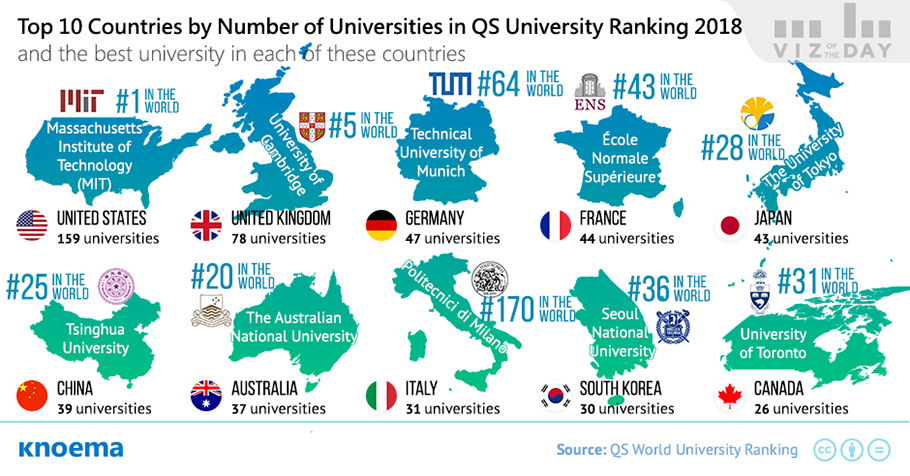Every year a new class of college applicants from all over the world chooses from among 1000s of universities to hang their ambitions. Several respected agencies publish regular ratings for some of the best universities in the world, including QS, the Academic Rating of World Universities, the Center for World University Rankings (CWUR), Times Higher Education (THE), and U.S. News, to establish guidelines for student choice and to systematize the information available about institutions of higher education.
- Annual rankings from the likes of QS evaluate universities based on a relatively standard set of factors but vary the underlying criteria and importance placed on each factor and sometimes introduce unique indicators that mean the difference between MIT being ranked number 1 by QS and number 5 by THE.
- THE introduces measures for the quality of teaching and research and the level of dissemination of knowledge and innovation while U.S. News delves into the reputation of universities' research and academics. The Shanghai rating is somewhat specialized, with a focus on the scientific and academic activities of universities in an aim to reduce the impact of the characteristics of national education systems on its final assessment. In contrast, the QS rating examines the reputation of universities within the academic environment.
While university ratings may create decision frameworks for potential students and employers, data shows that certain factors may be more meaningful in practice, only some of which are captured by ratings agencies.
- The greatest draw for foreign students is the variety of programs offered by a university, ranging from specialty sciences, such as nuclear physics, to narrow fields of creative arts, including filmmaking.
- The reputation of universities and the comprehensive nature of the training programs offered are also highly valued by students and employers and the ratings seek to provide unique measures of these attributes.
- Learn more about each ranking: Academic Rating of World Universities; the Center for World University Rankings (CWUR); Times Higher Education (THE); U.S. News.
In today’s Viz, we highlight the QS rating. This ranking introduces a student-to-faculty ratio, which is one of the most effective proxy metrics for teaching quality because of the reduced burden, on average, on the university’s academics. The QS criteria are as follow:
- Academic reputation (40%) - Academic experts’ opinions on the educational process in the university
- Employer reputation (10%) - Employers’ opinions on graduates and the quality of education
- Student-to-faculty ratio (20%) - Universities with the smallest groups and individual teachers
- Citations per faculty (20%) - Influence of the university on the field of scientific research
- International faculty ratio (5%) - The best conditions for foreign teachers
- International student ratio (5%) - The best conditions for foreign students
Материалы по теме
The CWUR World University Rankings
World university rankings are lists of higher education institutions ordered using a combination of indicators. Some rankings rely mainly on research indicators, while others place a great deal of emphasis on opinion based surveys. Up to now, there has been no ranking measuring the quality of the learning environment as well as research without relying on surveys and university data submissions. The CWUR ranking measures the quality of education and training of students as well as the prestige of the faculty and the quality of their research could be constructed based solely on verifiable data. The results show that in addition to research...
Which university degrees give the best financial returns?
The world's top economies increasingly depend on skilled workers, with college graduates in high demand. A report from the research firm PayScale provides calculations on the returns to higher education in US universities. Its authors compare the career earnings of college graduates with the present-day cost of a degree at their universities. Top universities may be growing ever more selective, but the returns on a college degree still depend far more on field of study than the choosiness of the university itself, according to PayScale. Engineering and computer-science students earn most, achieving an impressive 20-year annualised return of...
Financial Times, Masters in Management 2015
Financial Times presents new version of ranking. The data involve indicators which usually being considered by enrollees while choosing univercity and programme. In our dashboard some of them are vizualized. Although the headline ranking figures show changes in the data year to year, the pattern of clustering among the schools is equally significant. Some 215 points separate the top programme, University of St Gallen, from the school ranked number 80. The top 12 participants, from University of St Gallen to Esade Business School, form the top group of Masters in Management providers. The second group, headed by WU (Vienna University of...
